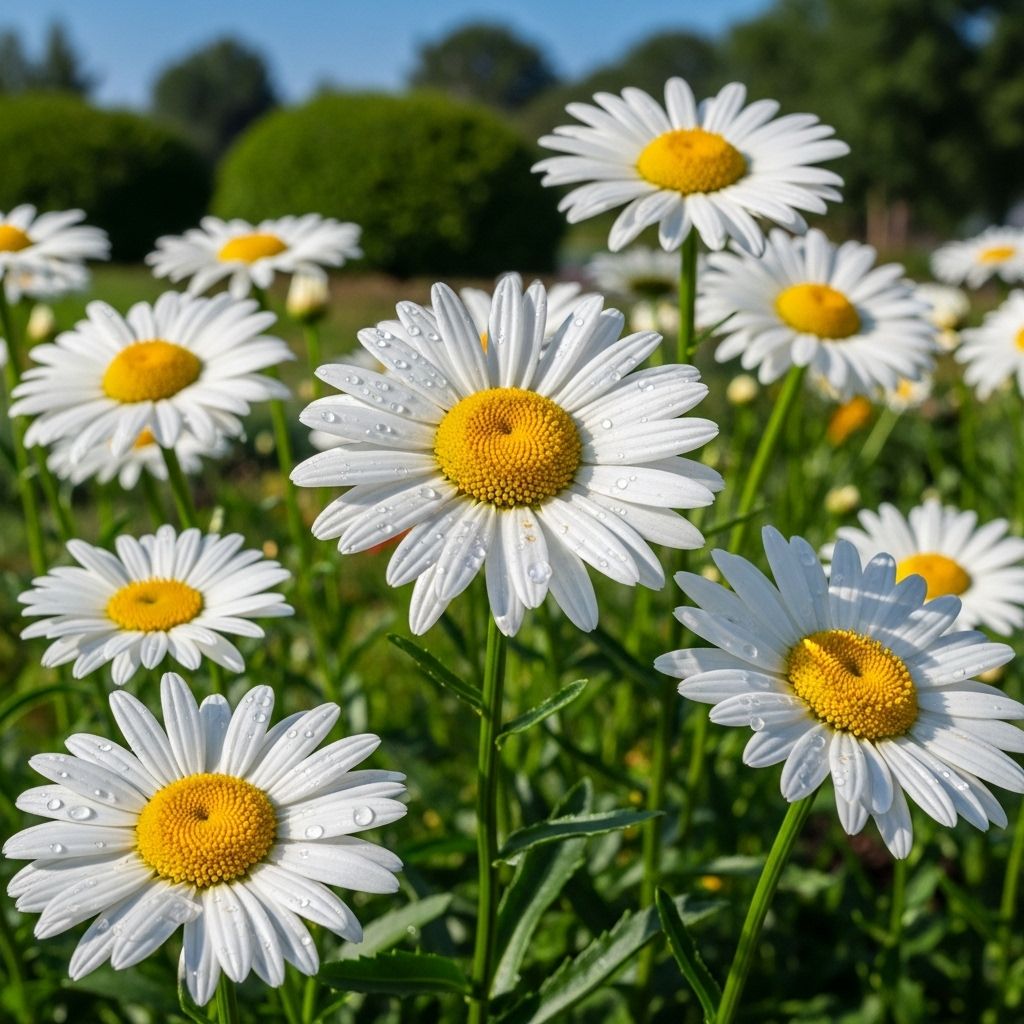How To Grow Shasta Daisies: Essential Guide For Vibrant Blooms
Brighten your garden with easy-to-maintain blossoms that bring endless joy and charm!

Image: HearthJunction Design Team
Shasta Daisy: The Complete Guide to Growing and Caring for These Cheerful Perennials
Few flowers capture the classic, carefree charm of a daisy quite like the beloved Shasta daisy. With their pristine white petals radiating from golden centers, these perennial favorites bring a cheerful presence to gardens from late spring through summer. Whether you’re looking to add a touch of traditional elegance to your landscape or seeking reliable bloomers for cutting gardens, Shasta daisies deliver with their simple beauty and easy-growing nature.
Developed in the 1890s by renowned botanist Luther Burbank in California, Shasta daisies (Leucanthemum × superbum) have become garden staples worldwide. Their name pays homage to California’s snow-capped Mount Shasta, reflecting the pure white of their petals. These hybrid perennials combine the best traits of several European daisy species, resulting in larger blooms and improved garden performance.
About Shasta Daisies
Shasta daisies are short-lived perennials belonging to the Asteraceae family, which includes sunflowers, zinnias, and other daisy-like blooms. Their classic appearance features white ray petals surrounding a bright yellow disc center, creating that iconic daisy look that’s instantly recognizable.
These reliable bloomers typically reach 1-3 feet in height, depending on the variety, with a spread of 1-2 feet when mature. Their dark green, glossy foliage creates an attractive base even when the plants aren’t in bloom, though it’s the flowers that truly steal the show. The blooms, which can measure 3-5 inches across in some varieties, make excellent cutting flowers, lasting well in arrangements.
Plant Characteristics
| Characteristic | Description |
|---|---|
| Botanical Name | Leucanthemum × superbum |
| Plant Type | Herbaceous perennial |
| Mature Size | 9 inches to 3 feet tall, 1-2 feet wide |
| Sun Exposure | Full sun to partial shade |
| Soil Type | Well-draining, loamy soil |
| Soil pH | Neutral (6.5-7.0) |
| Bloom Time | Late spring through summer |
| Flower Color | White petals with yellow centers |
| Hardiness Zones | 5-9 (USDA) |
| Native Area | Hybrid with no native range |
How to Plant Shasta Daisies
Shasta daisies are relatively easy to establish in the garden when given the right growing conditions. They perform best in locations that receive at least 6 hours of direct sunlight daily, though they can tolerate light shade in hotter climates.
When to Plant
The ideal time to plant Shasta daisies is in spring or early fall. Spring planting gives the roots time to establish before summer heat arrives, while fall planting allows establishment before winter dormancy. In milder climates, they can also be planted during mild spells in winter.
Site Selection
Choose a planting location with these characteristics:
- Full sun (at least 6 hours daily) for best flowering
- Well-draining soil to prevent root rot
- Protection from strong winds that might damage tall varieties
- Adequate space for air circulation between plants
Planting Steps
Follow these simple steps when planting your Shasta daisies:
- Prepare the soil by loosening it to a depth of 12-15 inches and amending with compost or other organic matter.
- Dig holes twice as wide as the root balls and slightly deeper.
- Space plants 1-2 feet apart, depending on the variety (check plant tags for specific spacing recommendations).
- Remove plants from their nursery containers and gently loosen any circling roots.
- Place each plant in its hole with the top of the root ball level with the surrounding soil.
- Backfill with soil, firming gently around the roots to eliminate air pockets.
- Water thoroughly after planting and continue to water regularly until established.
For container planting, choose pots at least 12 inches in diameter with drainage holes. Use a quality potting mix containing loam (such as a John Innes type) rather than garden soil.
How to Care for Shasta Daisies
Once established, Shasta daisies are relatively low-maintenance perennials. However, providing the right care will ensure the most abundant blooms and healthiest plants.
Watering
While Shasta daisies are somewhat drought-tolerant once established, they perform best with consistent moisture, especially during their first growing season. Water deeply when the top inch of soil feels dry, aiming to keep the soil evenly moist but never soggy. Established plants can tolerate brief dry periods but will produce more flowers with regular watering during extended drought.
Soil and Fertilizing
Shasta daisies prefer well-draining, moderately fertile soil with a neutral pH. They benefit from:
- An annual application of compost or well-rotted manure in spring
- A balanced, slow-release fertilizer applied in early spring
- A layer of mulch to retain moisture and suppress weeds
Avoid over-fertilizing, as this can lead to excessive foliage growth at the expense of flowers and may make stems weak and floppy.
Pruning and Maintenance
Regular maintenance keeps Shasta daisies looking their best and encourages continued blooming:
- Deadhead spent flowers by cutting stems back to the base to promote additional blooms
- Stake tall varieties in spring before they reach full height to prevent flopping
- Cut back all foliage to ground level after the first killing frost in fall or in early spring before new growth begins
- Divide plants every 2-3 years to maintain vigor and prevent overcrowding
Division
Dividing Shasta daisies every few years is essential for maintaining plant health and vigor. The best time to divide is in early spring as new growth begins to emerge, or in early fall. To divide:
- Dig up the entire clump of plants
- Gently separate the root mass into smaller sections, ensuring each division has roots and several growth points
- Replant divisions at the same depth they were previously growing
- Water well and keep moist until new growth appears
Common Problems and Solutions
While Shasta daisies are generally problem-free, they can occasionally face certain issues:
Pests
Shasta daisies may attract aphids, leaf miners, or slugs. Control these pests by:
- Spraying affected plants with a strong stream of water to dislodge aphids
- Removing and disposing of damaged leaves
- Setting up slug traps or barriers
- Encouraging beneficial insects like ladybugs and lacewings
Diseases
Potential disease issues include powdery mildew, leaf spot, and stem rot, particularly in humid conditions. Prevent these problems by:
- Ensuring adequate spacing between plants for good air circulation
- Avoiding overhead watering, especially in the evening
- Removing and disposing of affected foliage
- Dividing overcrowded plants to improve airflow
Shasta Daisy Varieties
The world of Shasta daisies offers numerous cultivars that vary in height, bloom size, petal arrangement, and flowering period. Here are some outstanding varieties to consider for your garden:
Classic Varieties
- Becky – A tall, sturdy variety reaching 3-4 feet with 3-inch blooms; excellent heat tolerance and strong stems that rarely need staking
- Alaska – One of the original varieties bred by Luther Burbank; grows 2-3 feet tall with classic single white blooms
- Crazy Daisy – Features frilly, quilled, or twisted petals for a shaggy, informal look; grows 24-28 inches tall
Compact Varieties
- Snow Lady – A dwarf variety reaching just 10-12 inches tall, perfect for containers or front edges of borders
- Little Miss Muffet – Compact plants growing 8-12 inches tall with abundant blooms
- Snowcap – A medium-height variety (12-15 inches) with particularly large flowers
Landscape Design with Shasta Daisies
Shasta daisies are versatile additions to the garden landscape, working well in numerous design applications. Their bright white blooms provide excellent contrast against deeper colors and their informal charm suits many garden styles.
Garden Uses
Consider incorporating Shasta daisies in these landscape settings:
- Perennial borders – Plant in drifts for maximum impact
- Cottage gardens – Their casual elegance fits perfectly with the informal cottage style
- Cutting gardens – Essential for their long-lasting blooms in arrangements
- Container plantings – Compact varieties work well in pots and planters
- Wildflower meadows – Mix with native plants for a naturalistic look
- Rock gardens – Shorter varieties complement alpine plants
Companion Planting
Shasta daisies combine beautifully with these companion plants:
- Purple coneflowers (Echinacea) – The purple tones contrast wonderfully with white daisies
- Black-eyed Susans (Rudbeckia) – Yellow and white create a cheerful combination
- Salvias – Blue or purple varieties provide striking color contrast
- Ornamental grasses – Add textural interest and movement
- Lavender – Complements the informal feel of daisies while adding fragrance
- Coreopsis – Yellow varieties echo the daisy’s center color
Shasta Daisies in Containers
Compact varieties of Shasta daisies make excellent container plants, bringing their cheerful blooms to patios, decks, and other small spaces. For successful container growing:
- Choose pots at least 12 inches in diameter with drainage holes
- Use high-quality potting mix designed for containers
- Select compact varieties like ‘Snow Lady’ or ‘Snowcap’
- Water more frequently than in-ground plants, as containers dry out faster
- Feed regularly with a balanced liquid fertilizer throughout the growing season
- Protect containers from extreme cold in winter by moving to a sheltered location
Frequently Asked Questions
Q: Are Shasta daisies deer resistant?
A: Yes, Shasta daisies are generally considered deer resistant. Their foliage has a slightly bitter taste that deer typically avoid, making them a good choice for gardens in areas with high deer pressure.
Q: Do Shasta daisies come back every year?
A: Yes, Shasta daisies are perennials that return each year in their hardiness zones (USDA zones 5-9). However, they are relatively short-lived perennials and may need to be divided every 2-3 years to maintain vigor and prevent the center of the clump from dying out.
Q: When should I cut back Shasta daisies?
A: Deadhead spent blooms throughout the growing season to encourage more flowers. Cut the entire plant back to ground level in late fall after the first frost or in early spring before new growth begins.
Q: Why are my Shasta daisy leaves turning yellow?
A: Yellowing leaves can indicate several issues: overwatering, poor drainage, nutrient deficiency, or normal aging of lower leaves. Check soil moisture and drainage first, as Shasta daisies prefer well-draining soil and can suffer from root rot in soggy conditions.
Q: How long do Shasta daisies bloom?
A: With proper deadheading, Shasta daisies typically bloom from late spring through mid-summer. Some varieties may produce a second flush of flowers in early fall if cut back after their initial flowering period.
Q: Are Shasta daisies invasive?
A: While Shasta daisies can self-seed and spread in ideal conditions, they are not generally considered invasive in most regions. Regular deadheading prevents unwanted self-seeding, and their clumping growth habit is relatively contained compared to truly invasive species.
Q: Can Shasta daisies grow in shade?
A: Shasta daisies prefer full sun but can tolerate light shade, especially in hotter climates. However, too much shade will result in fewer flowers, leggier growth, and potential disease issues from poor air circulation.
With their carefree charm and reliable blooming, Shasta daisies continue to be garden favorites for good reason. Whether planted in sweeping drifts in a perennial border, tucked into a cottage garden, or showcased in containers, these classic flowers bring a touch of cheerful elegance to any garden setting.
References
- https://www.almanac.com/plant/shasta-daisies
- https://www.provenwinners.com/learn/how-plant/shasta-daisy
- https://www.thespruce.com/shasta-daisy-growing-guide-5209135
- https://www.bhg.com/gardening/plant-dictionary/perennial/shasta-daisy/
- https://www.gardenersworld.com/how-to/grow-plants/how-to-grow-leucanthemum/
Read full bio of Srija Burman












